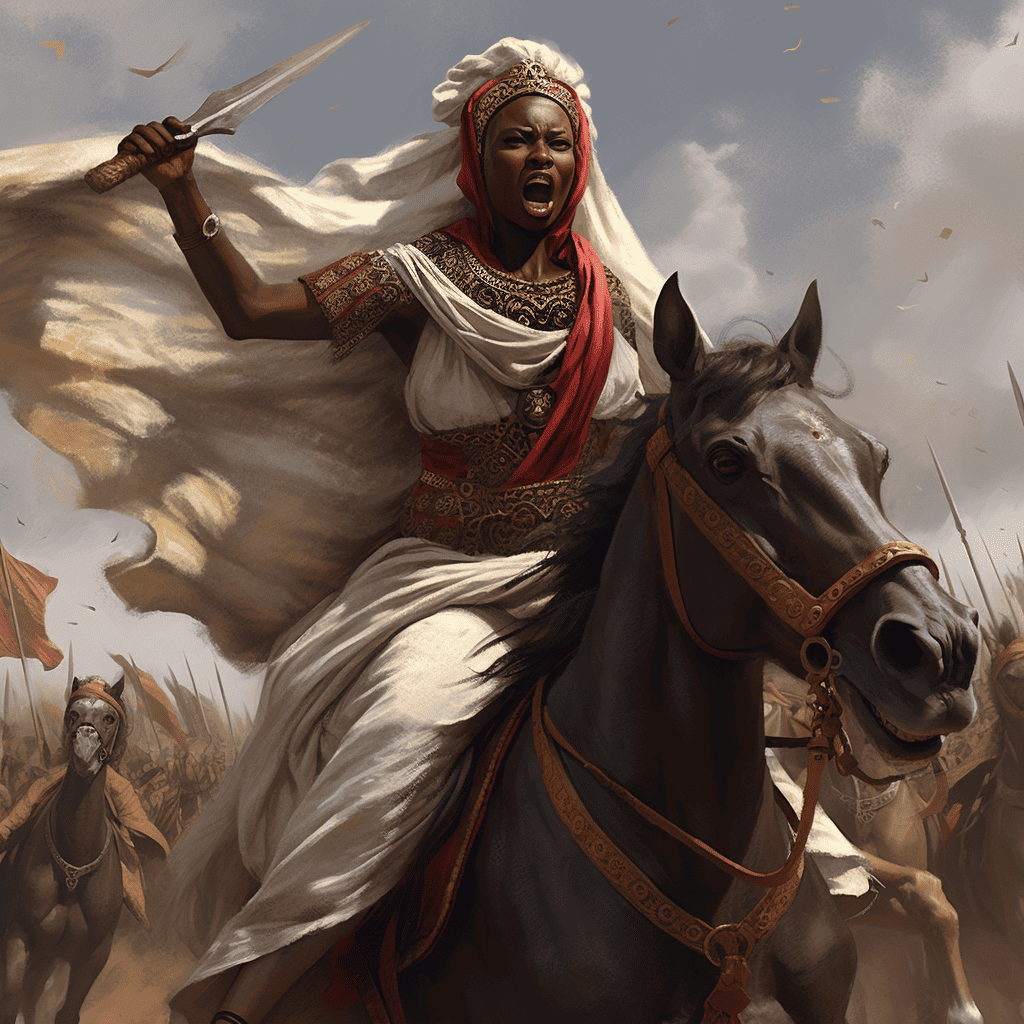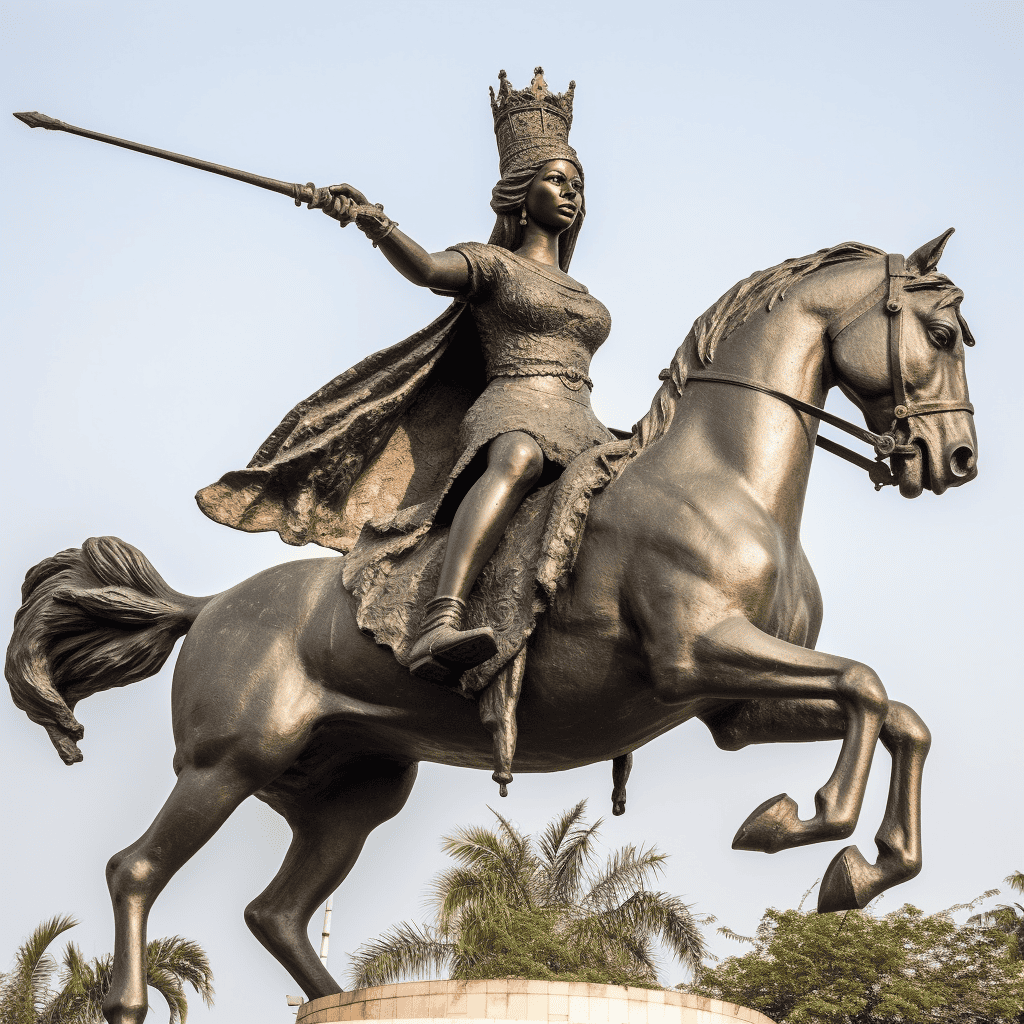Queen Amina of Zazzau, a 16th-century ruler in present-day Nigeria, was renowned for expanding the domain of the Zazzau Kingdom. A skilled military strategist and trade enhancer, she fortified her realm with walls, many of which stand today, symbolizing her legacy of leadership and strength.
The existence of this enigmatic figure has been challenged by some historians, and the truth of her life story has been shrouded in mystery, further entangled by an abundance of subsequent myths and folklore.
Early Life of Queen Amina
Amina was born amidst the sixteenth century CE to King Nikatau, the 22nd sovereign of Zazzau, and the esteemed Queen Bakwa Turunku (1536–1566).

She had a cherished younger sister named Zaria, after whom the contemporary city of Zaria (Kaduna State) was renamed by the British in the early twentieth century.
Anthropologist David E. Jones gathered fascinating oral legends that depicted Amina’s upbringing in her grandfather’s court, where she was doted upon. He would carry her around court and diligently impart knowledge of politics and military strategies.

From a young age, Amina exhibited a fervent passion for politics and public affairs, mastering political skills from both her mother and her grandfather, a Hausa ruler. At the age of sixteen, her mother appointed her Magajiya (heir apparent) of Zazzau, thus granting her a seat in the ruler’s cabinet.
An anonymous book, Amina, Sarauniya Zazzau (Amina, Queen of Zazzau), penned shortly after her demise, sheds light on her life. Amina defied the norms of her time in Zazzau, embracing her zeal for warfare and undergoing extensive military training.
Her reputation as a woman equal to a man stemmed largely from her fearless warrior spirit. Amina’s courage and expertise in battle swiftly cemented her position as Zazzau’s foremost warrior.
Rumour has it that Amina revelled in warfare and remained indifferent to the numerous suitors seeking her hand in marriage. From a young age, various suitors tried to woo her with extravagant gifts, such as “a daily offer of ten slaves” from Makama and “fifty male slaves and fifty female slaves along with fifty bags of white and blue cloth” from the Sarkin Kano.

Following her mother’s passing around 1566, Amina’s brother Karama claimed the throne. Unlike Bakwa, Karama was drawn to warfare and aimed to expand the Zazzau empire. Within two years of becoming king, he had orchestrated four significant military campaigns, all of which Amina valiantly fought in. At this juncture, Amina had earned a reputation as a “leading warrior in her brother’s cavalry” and became renowned for her military prowess. Today, traditional Hausa praise songs still honour her as “Amina, daughter of Nikatau, a woman as capable as a man, able to lead men into battle.”
Rise of Queen Amina and the expansion of Zazzau
Following her brother Karami’s demise in 1576, Amina rose to the esteemed position of queen. The kingmakers exhibited no reluctance in appointing her as the ruler of the kingdom. Zazzau was one of the original seven Hausa States (Hausa Bakwai), alongside Daura, Kano, Gobir, Katsina, Rano, and Garun Gabas. Prior to Amina’s ascension, Zazzau was among the largest of these states and served as the primary source of slaves for the Kano and Katsina slave markets, where Arab merchants traded.

Queen Amina ushered in an era of unparalleled prosperity; she enhanced her kingdom’s wealth and influence through gold, slaves, and the introduction of new crops. As her people were skilled metalworkers, Amina equipped her army with metal armour, including iron helmets and chain mail.
A mere three months after her coronation, Amina embarked on a 34-year conquest against neighbouring territories to expand Zazzau’s domain. Her formidable army, comprised of 20,000 infantry and 1,000 cavalry, was highly trained and instilled fear in their adversaries. In fact, one of her initial proclamations to her subjects urged them to “resharpen their weapons.”Amina successfully claimed vast expanses of land, stretching as far as Kwararafa and Nupe.

Under Queen Amina’s reign, Zazzau’s territorial control reached unprecedented levels. To demarcate and safeguard her newly acquired lands, Amina commissioned the construction of earthen walls around her cities. These walls remained a common sight across the nation until the British conquest of Zazzau in 1904, and many still stand today, recognised as ganuwar Amina (Amina’s walls).
The expansion of Amina’s kingdom transformed it into the trading hub for all southern Hausaland, straddling the traditional east-to-west trans-Saharan axis and ensuring Zaria’s affluence.
Legends documented by Sidney John Hogben claim that Amina took a new lover in every town she visited, each of whom would ultimately meet a tragic end the following morning: “Her fleeting bridegroom was beheaded to ensure that none would live to reveal the tale.”
Death of Queen Amina
Queen Amina of Zaria passed away 34 years later (1610), leaving a lasting legacy as the first woman to govern the African Kingdom.
Sidney John Hogben notes that “Amina met her end in Atagara, near present-day Idah, as by that time, Amina had expanded the borders of Zazzau south of the Niger-Benue confluence.” However, her demise is shrouded in mystery and contradiction; various authors have cited Vom Jos as her final resting place, while other historians maintain that she perished in Atagara, now known as Idah.
Legacy of Queen Amina
Amina is celebrated as a courageous, intelligent, and gifted leader. To pay tribute to her remarkable achievements, Nigeria has immortalised her legacy with a majestic statue in the heart of Lagos. The statue depicts her, spear in hand, mounted on a horse, while numerous educational institutions bear her name.

Despite the prevailing systematic oppression and limited autonomy for women during her time, a triumphant ruler like Amina left a profound impact that is cherished by intersectional feminists as a significant milestone in Northern African history.
Amina is not only revered for her trailblazing efforts as a female warrior but also for her innovative military strategies, including the construction of fortified walls surrounding Zazzau cities.
Related Posts
Sources
“Queen Amina,” Encyclopedia.com, accessed May 6, 2023, https://www.encyclopedia.com/history/news-wires-white-papers-and-books/queen-amina
UK Platinum Services, “Platinum Black History Month: The Queen of Zaria, Nigeria – Amina,” UK Platinum Services Blog, accessed May 6, 2023, https://www.ukplatinumservices.com/blog/platinum-black-history-month-the-queen-of-zaria-nigeria-amina.
“Amina (Queen of Zazzau),” Wikipedia, last modified October 11, 2021, https://en.wikipedia.org/wiki/Amina_(Queen_of_Zazzau).





